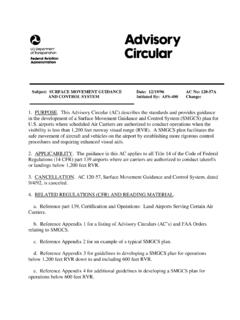Transcription of Advisory - faa.gov
1 Department of Transportation Advisory Federal Aviation Administration Circular Subject: Exception for Limited Recreational Date: 5/31/19 AC No: 91-57B. Operations of Unmanned Aircraft Initiated by: AFS-800 Change: 1 PURPOSE OF THIS Advisory CIRCULAR (AC). This AC provides interim safety guidance to individuals operating unmanned aircraft, often referred to as drones, for recreational purposes under the statutory exception for limited recreational operations of unmanned aircraft (Title 49 of the United States Code (49 ) 44809). This AC. restates the statutory conditions to operate under the exception and provides additional guidance on adhering to those conditions.
2 Per 49 44809, recreational flyers may only operate under the statutory exception if they adhere to all of the conditions listed in the statute. Effect of Guidance. This guidance is not legally binding in its own right and will not be relied upon by the Department of Transportation (DOT) or the Federal Aviation Administration (FAA) as a separate basis for affirmative enforcement action or other administrative penalty. Regardless of whether you rely on this guidance, you are independently required to comply with all existing laws applicable to the operation of unmanned aircraft.
3 Conforming your actions with this guidance is voluntary and nonconformity will not affect any right or obligation under any existing statute or regulation. 2 AUDIENCE. This AC provides guidance to individuals operating unmanned aircraft for recreational purposes in the National Airspace System (NAS) of the United States. The use of the term recreational operations in this AC refers to operations described in 49 44809(a). 3 WHERE YOU CAN FIND THIS AC. You can find this AC on the FAA's website at 4 WHAT THIS AC CANCELS. AC 91-57A CHG 1, Model Aircraft operating Standards, dated January 11, 2016, is canceled.
4 5 REFERENCES. This guidance relates to 49 44809. 6 RELATED READING MATERIAL (current editions): Title 49 Subtitle VII. Title 14 of the Code of Federal Regulations (14 CFR). AC 107-2, Small Unmanned Aircraft Systems (sUAS), which contains 14 CFR. part 107 guidance. 5/31/19 AC 91-57B. Pilot's Handbook of Aeronautical Knowledge (PHAK). FAAD roneZone: Unmanned Aircraft System (UAS) Data Delivery System: Temporary Flight Restriction (TFR) listing: The FAA's Airspace Restrictions website: Notices to Airmen (NOTAM): Academy of Model Aeronautics (AMA) Safety Handbook: FAA National Aviation Events Program website: FAA Unmanned Aircraft Registration website: Federal Register (FR) Notice 84 FR 22552, Exception for Limited Recreational Operations of Unmanned Aircraft.
5 7 RECREATIONAL UNMANNED AIRCRAFT OPERATIONS. Unmanned aircraft are aircraft without a human pilot on board; they are controlled by an operator on the ground. Operators flying unmanned aircraft can endanger other aircraft, people, or property when flying recklessly or without regard to risks. Additionally, most unmanned aircraft manufactured for recreational use are not tested to any FAA standards for airworthiness, meaning they come with no assurance they will stay airborne or fly in a predictable manner, especially when encountering unexpected circumstances such as radio interference, winds, or power failures.
6 When you fly an unmanned aircraft in the United States, it is your responsibility to ensure the safety of the flight, and to understand and follow the appropriate Federal, state, and local laws. 1. The FAA assumes owners and operators of unmanned aircraft are generally concerned about safety and willing to exercise good judgment when flying their aircraft. However, basic aeronautical knowledge and awareness of responsibilities in shared airspace are not common knowledge. 2. The FAA intends to provide a process for recognizing community-based organizations (CBO) and their safety guidelines for recreational flyers in consultation with manufacturers of UAS, CBOs, and other industry stakeholders upon full implementation of 49 44809.
7 In the meantime, this interim guidance provides information on the statutory conditions and basic safety guidelines for recreational flyers. Nevertheless, recreational flyers must always remain aware that any operations endangering the safety of the NAS (particularly careless or reckless operations, those endangering persons or property, and/or those that interfere with or fail to give way to any manned aircraft) will be subject to FAA compliance action. 2. 5/31/19 AC 91-57B. 3. Operators who do not fulfill the criteria of 49 44809(a) ( , those who wish to fly small unmanned aircraft for commercial purposes) or who wish to obtain an FAA-issued Remote Pilot Certificate, should review part 107 and the associated guidance in AC 107-2.
8 The guidance in AC 91-57. applies to flyers who only operate recreationally under the statutory exception. Statutory Conditions. Until further notice, paragraphs through provide guidance on how a person may meet the eight statutory conditions of the statutory exception of 49 44809 to operate a UAS for recreational purposes. A person who fails to meet any of the statutory requirements of 49 44809 may not operate UAS under the statutory exception and would need to operate them under part 107 or any other applicable FAA authority. The Aircraft is Flown Strictly for Recreational Purposes.
9 Any use of unmanned aircraft for commercial purposes must be conducted under part 107 or other applicable FAA. regulations ( , 14 CFR part 91, 135, or 137). The Aircraft is Operated in Accordance With or Within the Programming of a CBO's Set of Safety Guidelines That are Developed in Coordination With the FAA. Once the FAA. has developed the criteria for recognition of CBOs and started officially recognizing CBOs, those CBOs' safety guidelines will be available for use. During this interim period, the FAA offers two means to satisfy this statutory condition.
10 Recreational flyers should be able to explain to an FAA inspector or law enforcement official which safety guidelines they are following. The FAA acknowledges that existing aeromodelling organizations have developed safety guidelines that are helpful to recreational flyers. An example is the AMA safety guidelines, which have previously been reviewed by the FAA as part of the organization's Recognized Industry Organization (RIO). status for participation in the National Aviation Events Program (refer to FAA. Order , Volume 5, Chapter 9, Section 6, Issue/Renew/Reevaluate/Rescind an Air Boss Letter of Authorization).














